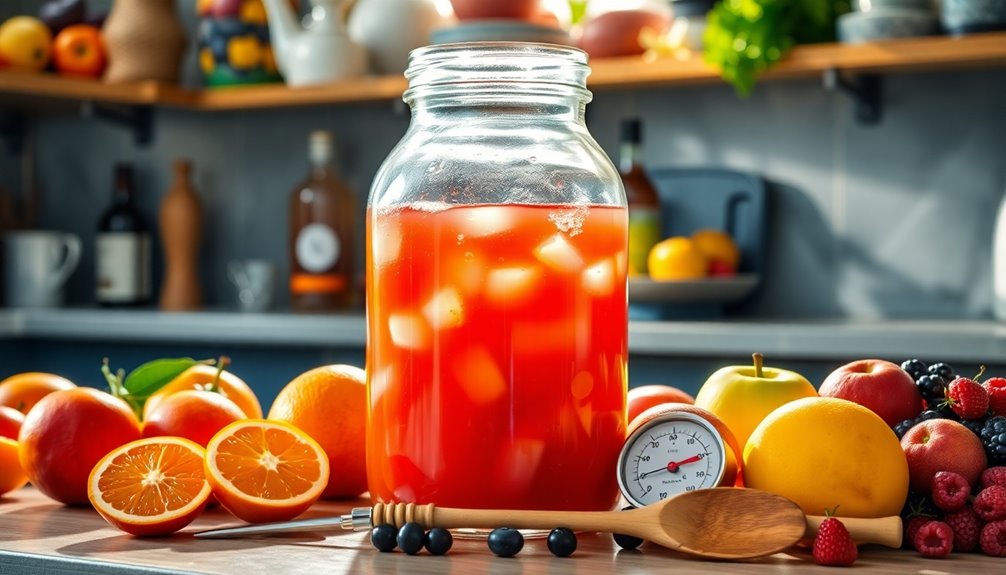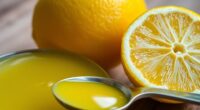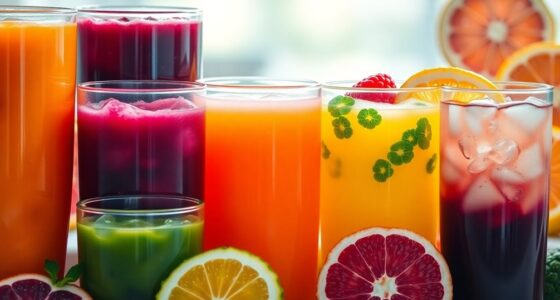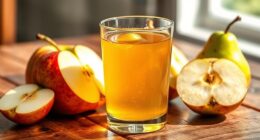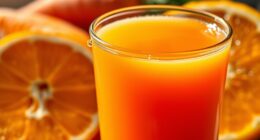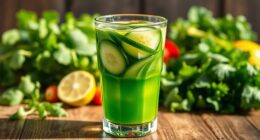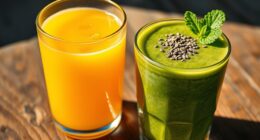To brew alcohol from juice, start by selecting a juice with at least 20 grams of sugar per serving, like grape or blackberry juice. Gather essential equipment, including a fermentation vessel, airlock, hydrometer, and sanitizing supplies. Clean and sanitize everything, then add yeast to the juice and seal it to create an anaerobic environment. Monitor fermentation progress and enhance flavor through techniques such as aging or adding spices. Stick around to explore more tips for a successful brew!
Key Takeaways
- Select a juice with at least 20 grams of sugar per serving and avoid preservatives for effective fermentation.
- Sanitize all equipment thoroughly to prevent contamination before starting the brewing process.
- Use a fermentation vessel equipped with an airlock to maintain anaerobic conditions during fermentation.
- Monitor specific gravity with a hydrometer to track sugar depletion and fermentation progress.
- Clarify and condition the brew post-fermentation for improved flavor and quality before bottling.
Selecting the Right Juice
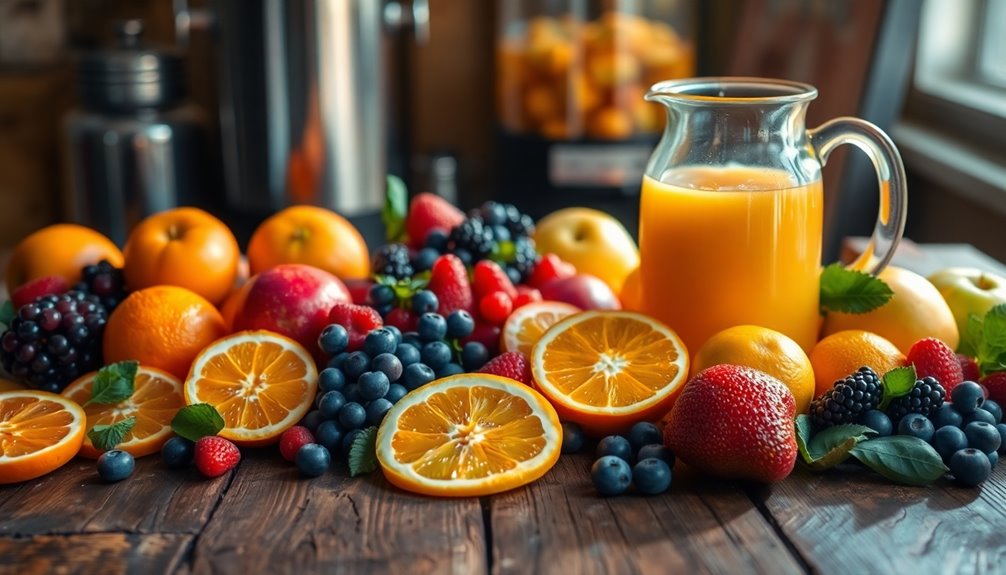
When it comes to selecting the right juice for fermentation, you’ll want to ensure it’s suitable for creating alcohol. Look for juices with at least 20 grams of sugar per serving, as sugar is essential for fermentation. Avoid juices with preservatives, since they can hinder yeast growth. Filtered juices are best, preventing sediment and ensuring clarity in your final product. Natural sweeteners outperform artificial ones, providing a more reliable fermentation process. Grape juice is a popular choice due to its high sugar content, but consider other options like blackberry juice for flavor. Additionally, incorporating juices that are rich in nutrients can enhance the complexity of your final product. Always check the juice’s flavor profile and ensure your yeast is compatible, as these factors greatly influence the success of your brewing endeavor. Additionally, consider using Hippie Juice's eclectic mix of fruits for a unique flavor twist in your fermentation process. Moreover, experimenting with different fruit combinations can lead to innovative flavors that make your fermentation experience more enjoyable. If you’re looking to keep costs down while still achieving excellent results, consider researching budgetfriendly juice production tips that emphasize using in-season fruits or local sources. These strategies not only save money but also support sustainable practices and can yield refreshingly unique beverages.
Essential Equipment You'll Need
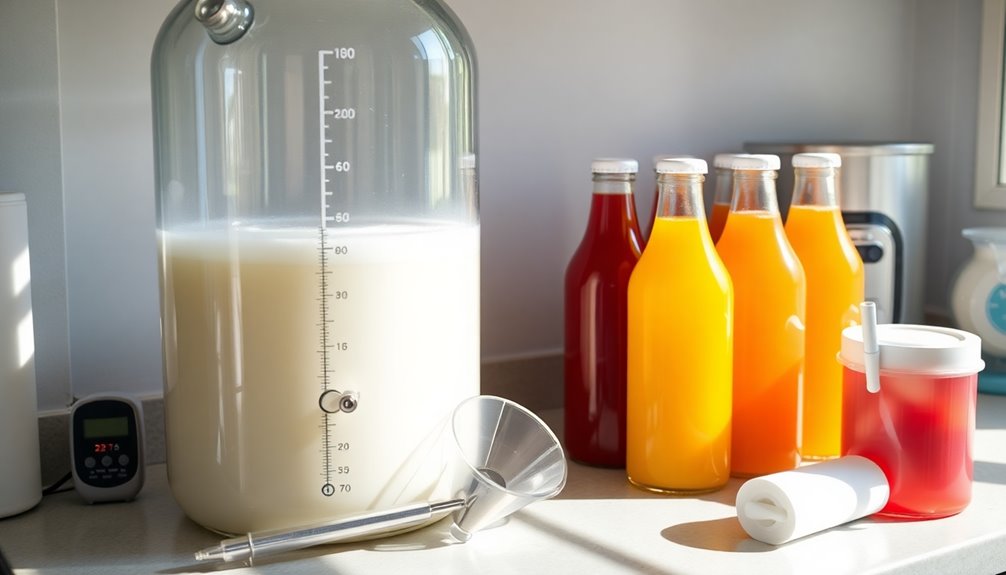
To successfully make alcohol from juice, you'll need several essential pieces of equipment that streamline the fermentation process. A carboy or fermentation bucket is ideal for larger batches, while bottles work well for smaller ones. Invest in an airlock and bung to allow CO2 to escape while keeping air out. To begin your brewing journey, make sure to choose juice that is free from preservatives and high acidity to ensure effective fermentation.
A hydrometer is crucial for measuring specific gravity, helping you calculate your alcohol content, while a pH meter and acid test kit will ensure optimal acidity levels. Don't forget a thermometer to monitor temperatures. For transferring your brew without disturbing sediment, use a siphon and racking cane. Finally, have your bottling equipment ready for the final stage of your brewing adventure.
Happy brewing!
Preparing and Sanitizing Your Equipment
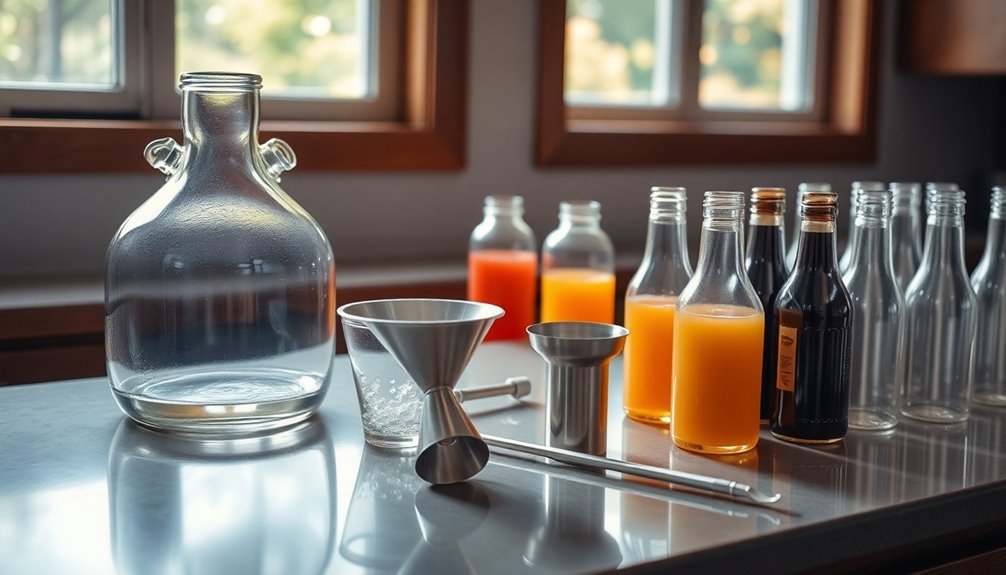
Before you dive into brewing alcohol from juice, ensuring your equipment is clean and sanitized is crucial. Start by using appropriate cleaning agents to remove debris and minimize microbial presence. Make sure the water you use for cleaning meets state and federal standards. Soak your equipment in a cleaning solution to loosen any caked-on material, then rinse thoroughly. After that, dry everything completely to prevent bacterial growth.
Next, sanitize your equipment with a suitable sanitizer, like a no-rinse solution. Remember that proper sanitation is essential to prevent contamination, which can compromise your brewing effort. Follow the manufacturer's instructions for dilution and contact time. Always sanitize immediately before use to avoid recontamination.
Regularly inspect your gear for wear, and store it in a clean, dry place to maintain sanitation.
Understanding the Fermentation Process
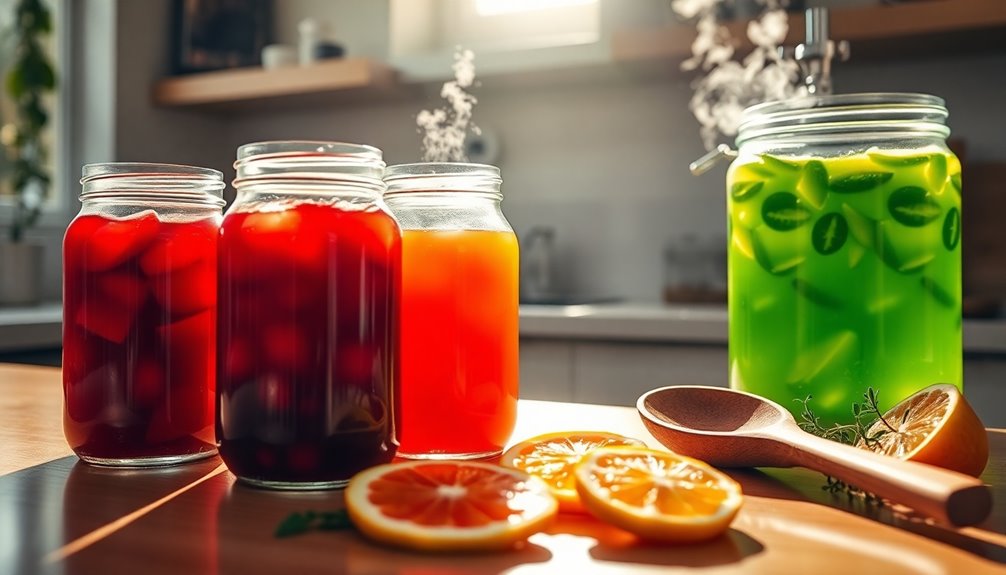
With your equipment ready, it's time to understand the fermentation process that transforms juice into alcohol. This process relies on yeast converting sugars into ethanol and carbon dioxide in an oxygen-free environment. It starts with glycolysis, where glucose breaks down into pyruvate, producing energy. Next, pyruvate gets converted into acetaldehyde and carbon dioxide, and then reduced to ethanol. Maintaining anaerobic conditions is crucial, so keep your fermentation vessel sealed. Temperature also matters; aim for a range between 15°C and 30°C for optimal yeast activity. Alcoholic fermentation occurs under these anaerobic conditions, enhancing the flavor and nutritional value of the final product. Monitor fermentation by checking specific gravity and CO2 production, which indicates progress. Choosing the right yeast can speed up the process and impact alcohol content, so select wisely.
Enhancing Alcohol Content
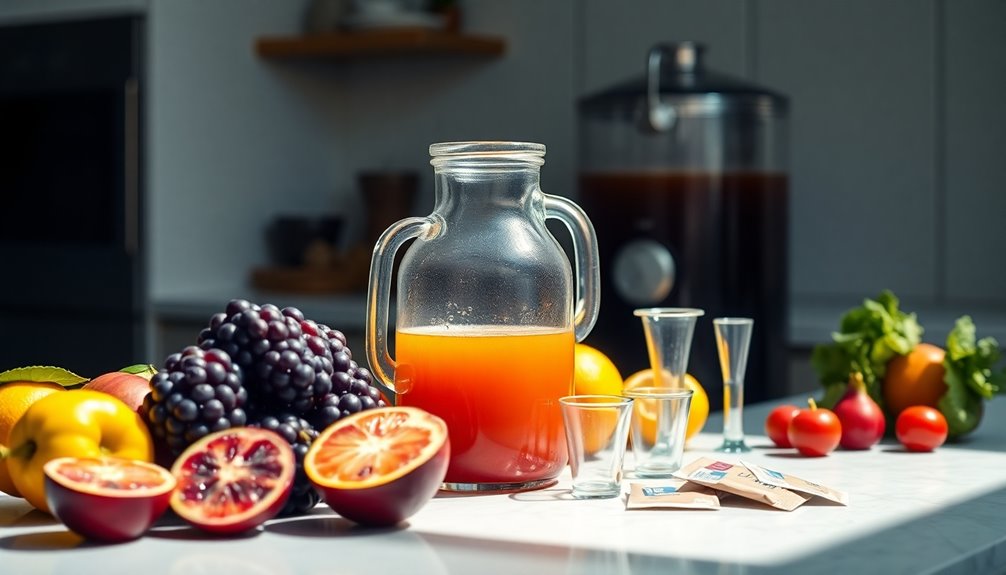
While enhancing alcohol content can be an exciting challenge, it requires a careful approach to ensure a balanced final product.
You can start by adding sugar, which boosts fermentable material for yeast. Simple sugars, like table sugar, increase hop bitterness, while complex sugars, like honey, enrich flavor and complexity. Additionally, using high alcohol tolerance yeasts will help maximize your ethanol yield.
Choose high-quality yeast strains that can handle increased sugar loads; a yeast starter helps ensure a robust cell count.
Controlling fermentation time and temperature is also vital—longer fermentation can yield higher alcohol, but monitor conditions to prevent off-flavors.
Finally, balancing additional ingredients, such as hops, is key to maintaining desired flavors in your brew.
Experimentation will help you find the perfect balance for your specific recipe.
Final Processing Techniques
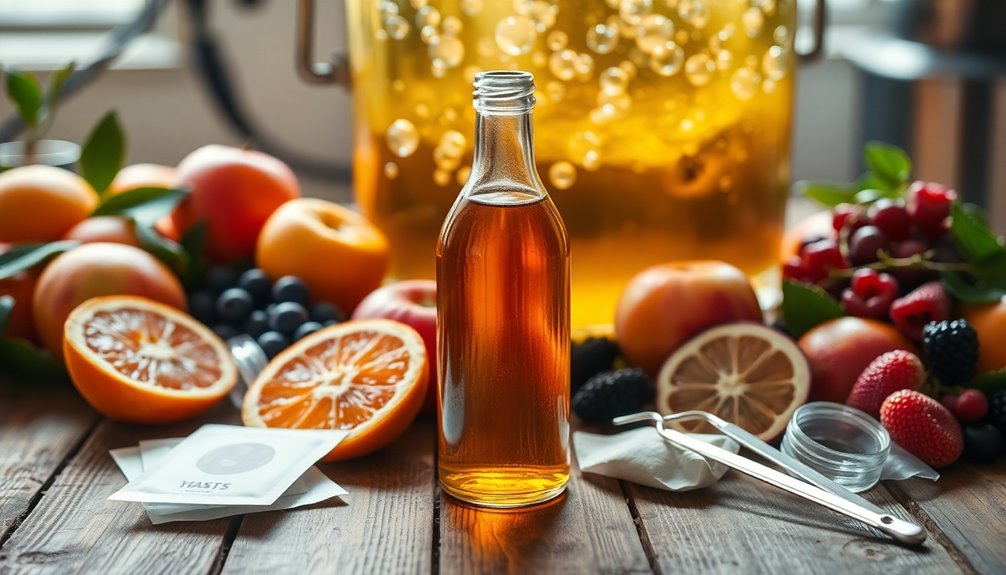
After enhancing the alcohol content, the next step is to focus on final processing techniques that refine your brew.
Start by clarifying the liquid using activated carbon to remove impurities and improve taste. Employ clearing agents like gelatin or kaolin to precipitate suspended particles, and consider filtration systems, such as paper filters, for additional clarity. For a more advanced option, you might use centrifugation to separate solids from liquids effectively.
Next, consider distillation, which separates ethanol from other components. Maintain precise temperatures to ensure efficient separation, achieving up to 95% ethanol purity. Fermentation produces a mixture of alcohol and carbon dioxide, which can affect the flavor profile during this process.
Finally, enhance flavors through aging in oak barrels or by adding spices and fruits. These techniques will elevate your brew's quality, preparing it for the next steps.
Proper Storage and Serving
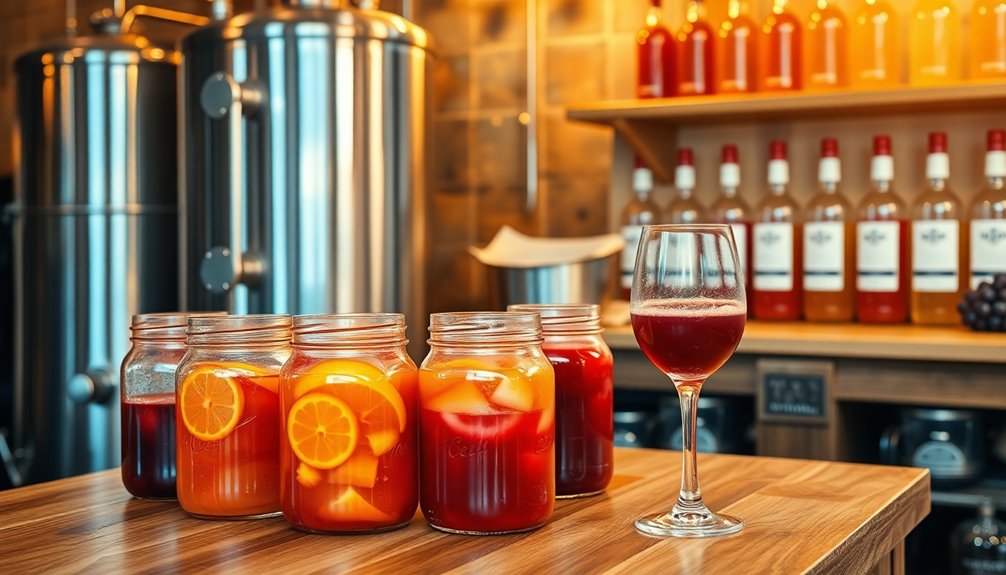
To ensure your homemade alcohol maintains its quality, proper storage and serving techniques are essential. Store your liquor in a cool, dark place, ideally between 55°F and 60°F. Avoid direct sunlight and fluctuating temperatures, which can alter flavors. Use glass or stainless steel containers, like mason jars or crown-capped bottles, and seal them tightly to prevent oxidation. Stable temperature maintenance is crucial for preserving the flavors of your homemade spirits over time.
When serving, consider chilling lighter spirits, while most can be served at room temperature. Decanting helps improve clarity and taste by separating sediment. Keep bottles upright to preserve flavors and prevent cork degradation. Lastly, remember that full bottles last longer than partially filled ones, so take care to minimize oxidation for the best experience.
Tips for Successful Fermentation
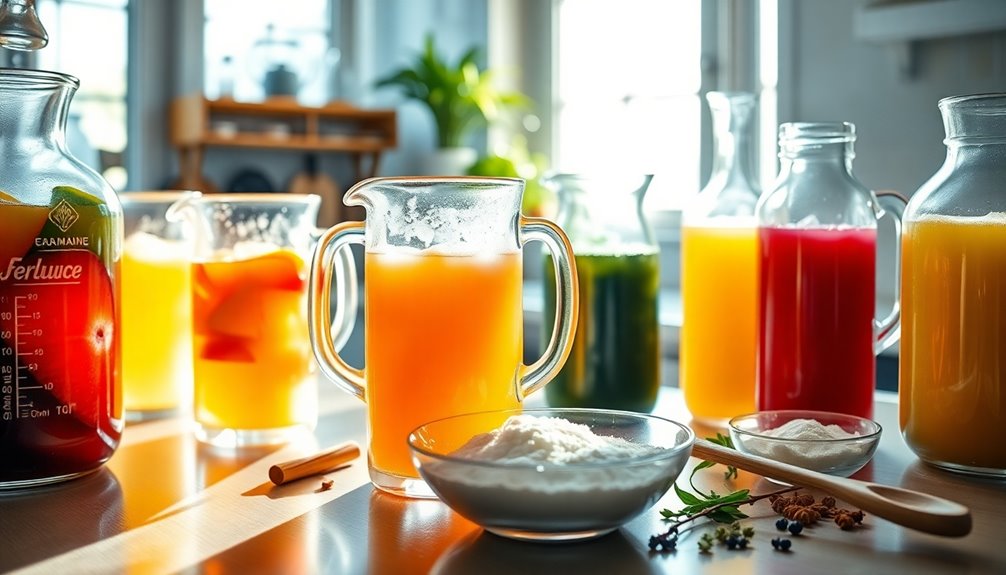
Successful fermentation hinges on meticulous preparation and attention to detail. First, sanitize all your equipment thoroughly to prevent contamination. Choosing the right yeast is crucial; it determines the alcohol content and flavor of your brew. Additionally, using HEPA filters in your brewing area can help ensure a cleaner environment, reducing the risk of contamination. Pay attention to the sugar content in your juice, as higher sugar levels can produce more alcohol. Maintain a consistent temperature between 60°F and 80°F for optimal yeast activity. Use juice without preservatives to ensure yeast survival. During fermentation, utilize an airlock to let CO2 escape while keeping oxygen out. Monitor the fermentation process by observing CO2 production. Additionally, remember that fermentation stops when sugars are depleted, which is essential for achieving the desired alcohol content. After primary fermentation, transfer your brew to a new vessel to remove dead yeast for better clarity and flavor. Patience during conditioning will enhance your final product.
Frequently Asked Questions
Can I Use Frozen Juice Instead of Fresh Juice?
Yes, you can use frozen juice instead of fresh juice! It's convenient, cost-effective, and available year-round.
However, keep in mind that frozen juice mightn’t have the same vibrant flavor or nutrient content as fresh juice. Nonetheless, frozen juice can still be a convenient option, especially when fresh fruits and vegetables are out of season. When considering the shelf life of fresh juice, many people often ask, “how long does fresh juice last? ” Typically, fresh juice can be stored in the refrigerator for up to 72 hours, but its flavor and nutrient content begin to degrade soon after it’s made. Therefore, it’s crucial to consume it as quickly as possible to enjoy the maximum benefits.
To get the best results, ensure you pasteurize it, thaw it slowly, and mix it well to avoid texture issues.
Always check the quality of the frozen juice to ensure a tasty end product.
What Type of Yeast Should I Avoid?
When choosing yeast for fermentation, you should avoid wild yeasts like *Kloeckera* and *Brettanomyces*, as they can produce off-flavors and may not finish fermentation.
Steer clear of low alcohol tolerance strains and those that produce excessive sulfur compounds.
Also, watch out for unpredictable yeasts that could lead to stuck fermentations or foaming issues.
Instead, opt for reliable strains like *Saccharomyces cerevisiae* for consistent results in your brewing process.
How Do I Know When Fermentation Is Complete?
You'd think fermentation's like a magic trick, but it's more of a science experiment.
To know when it's complete, measure the specific gravity with a hydrometer. When it stays constant over a few days, you're probably good.
Also, keep an eye on airlock activity—when those bubbles slow down, it's a sign.
Lastly, visual cues, like the krausen settling, can help you figure out if your brew's ready for the next step.
Can I Add Spices or Herbs During Fermentation?
Yes, you can add spices or herbs during fermentation, but timing's crucial.
If you add them too early, you might end up with unexpected flavors. Experimentation's key—start with small batches to find your preferred spice levels.
You can use a fine-mesh bag for easy removal, or try tinctures for controlled flavor intensity.
Just remember, certain spices can affect yeast activity, so keep an eye on your fermentation process.
Enjoy the creative journey!
Is It Safe to Drink Homemade Alcohol?
Drinking homemade alcohol can pose serious risks. You might encounter methanol poisoning, unpredictable alcohol content, and harmful contaminants if proper safety measures aren't followed.
Without the right equipment and knowledge, you could end up with a dangerous product. It's crucial to ensure clean fermentation, proper distillation, and verify your ingredients.
If you're unsure, consider opting for commercial alcohol or homebrewing kits to reduce health risks significantly. Always prioritize your safety!
Conclusion
Now that you've mastered the art of brewing alcohol from juice, you're ready to unleash your inner alchemist. With each batch, you'll transform simple ingredients into liquid gold, pouring creativity into every sip. Remember, patience is your secret ingredient, and experimentation is the key to unlocking new flavors. So, gather your friends, raise your glasses, and toast to your newfound skills. Cheers to the delightful journey of brewing—may it be as sweet as the juice you started with!
Cindy thoroughly researches juicing trends, techniques, and recipes to provide readers with practical advice and inspiration. Her writing style is accessible, engaging, and designed to make complex concepts easy to understand. Cindy’s dedication to promoting the advantages of juicing shines through her work, empowering readers to make positive changes in their lives through the simple act of juicing.

